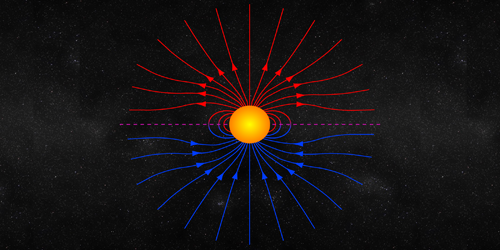Solar Cycle Affects Cosmic Ray Positrons
Recent observations of relatively low-energy positrons (antielectrons) in cosmic rays have not agreed with earlier measurements taken a decade ago. A new study confirms that the discrepancy is due to periodic changes in the direction of the Sun’s magnetic field as part of the solar cycle. Researchers analyzed 10-years-worth of data from the space-borne PAMELA mission and found that the positron fraction relative to electrons is highest when the solar magnetic field points north along its rotational axis.
Cosmic-ray positrons have become the target of much excitement because of a recently discovered anomaly at high energy ( >10 GeV), which hints at a possible dark matter origin. To understand the high-energy data, astrophysicists need a good handle on the low-energy data ( <5 GeV), but observations in this range seem to disagree. In particular, the PAMELA experiment reported a few years ago that their low-energy positron fraction was roughly 50% less than earlier observations.
But the PAMELA team now has new data that can explain the low-energy discrepancy. The team analyzed observations from 2006 to 2015 and found that the positron fraction increased dramatically in 2015, following a reversal in the direction of the Sun’s magnetic field. This sequence of events fits in line with a previously proposed model in which cosmic rays drift in certain directions depending on their charge and the field orientation. From 2006 to 2013, the solar field pointed south, and the drift caused fewer low-energy positrons to reach Earth. But the reversal in 2013–2014 turned the tables, and now fewer low-energy electrons are reaching us.
This research is published in Physical Review Letters.
–Michael Schirber
Michael Schirber is a Corresponding Editor for Physics.





